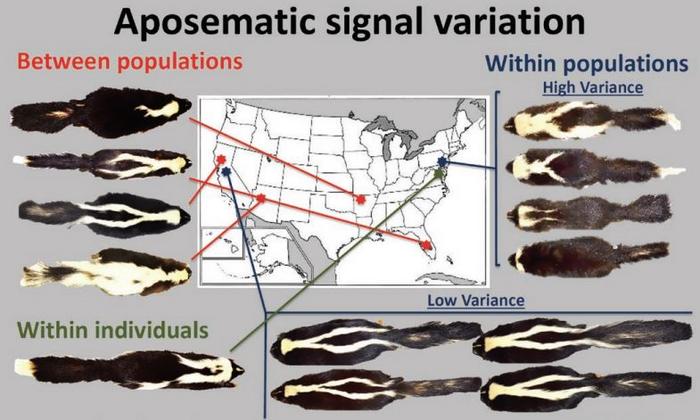Striped skunks are less likely to evolve with their famous and white markings where the threat of predation from mammals is low, scientists from the University of Bristol, Montana and Long Beach, California have discovered.

Credit: Prof Tim Caro
Striped skunks are less likely to evolve with their famous and white markings where the threat of predation from mammals is low, scientists from the University of Bristol, Montana and Long Beach, California have discovered.
Skunks’ iconic black and white colouration signals its toxic anal spray. However some skunks show very varied fur colour ranging from all black to thin or thick black and white bands to all white individuals. Variation is huge across the North American continent.
Findings published today in Evolution, suggest that this is a result of relaxed selection, when environmental change eliminates or weakens the selection of a normally important trait – in this case black and white pelage.
Prof Tim Caro from Bristol’s School of Biological Sciences explained: “Warning coloration is an antipredator defence whereby a conspicuous signal advertises the ability of prey to escape predation, often because it is toxic or has spines or is pugnacious.”
“Usually predators have to learn the significance of this signal and so it is predicted that warning colouration will look very similar across prey individuals of the same, as well as perhaps different, prey species to be an effective education tool. Yet some warningly coloured prey show rather different advertisements even within the same species.”
Researcher Hannah Walker from the University of Montana documented the distribution of these different pelage colours across their range in North America using museum specimens. She plotted these against a menu of variables that the team thought might drive this variation in coloration.
The team found that in locations in which skunks overlapped with rather few mammalian predators that might be capable of killing them, fur colour was varied even within the same litter.
Where there were many species of predators that were a danger to them, they showed little variation.
The team also examined owl and raptorial predators however while the effects were the same, they were not as evident. This is perhaps because birds have a poorer sense of smell and are less deterred by smelly anal defences.
“Our results indicate that relaxed predation pressure is key to warning signal variation in this species, whereas stronger pressure leads to signal conformity and stronger signals,” said Professor Caro.
“We now know why not all skunks look alike, and perhaps why members of other warningly coloured species look different from each other.”
Now the team plan to see if this occurs across other skunk species whose geographic ranges overlap in North America.
Prof Caro concluded: “If relaxed selection operates within species, it should do so across prey species too. More broadly, this study provides another brick in the wall of explaining the evolution of coloration in nature.”
Paper:
‘Predation risk drives aposematic signal conformity’ by Hannah Walker, Tim Caro et al in Evolution.
Journal
Evolution
Method of Research
Imaging analysis
Subject of Research
Animals
Article Title
Predation risk drives aposematic signal conformity
Article Publication Date
11-Sep-2023




